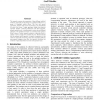Free Online Productivity Tools
i2Speak
i2Symbol
i2OCR
iTex2Img
iWeb2Print
iWeb2Shot
i2Type
iPdf2Split
iPdf2Merge
i2Bopomofo
i2Arabic
i2Style
i2Image
i2PDF
iLatex2Rtf
Sci2ools
FLAIRS
2003
2003
Emergence of Cooperation in a Multiple Predator, Single Prey Game
This research concerns the comparison of three different artificial evolution approaches for the design of cooperative behavior in a group of simulated mobile robots. The first and second approaches, termed: single pools and plasticity, are characterized by robots that share a single genotype, though the plasticity approach includes a learning mechanism. The third approach, termed: multiple pools, is characterized by robots that use different genotypes. The application domain is a pursuit-evasion game in which a team of robots, termed: predators, collectively work to capture or slow a single robot, termed: the prey. Results indicate that the multiple pools approach is superior comparative to the other two approaches in deriving robust and consistently effective prey-capture strategies, given that this approach facilitates the evolution of specialized behavioral roles in the predator team.
Artificial Evolution Approaches | Artificial Intelligence | FLAIRS 2003 | Multiple Pools | Simulated Mobile Robots |
| Added | 31 Oct 2010 |
| Updated | 31 Oct 2010 |
| Type | Conference |
| Year | 2003 |
| Where | FLAIRS |
| Authors | Geoff Nitschke |
Comments (0)

